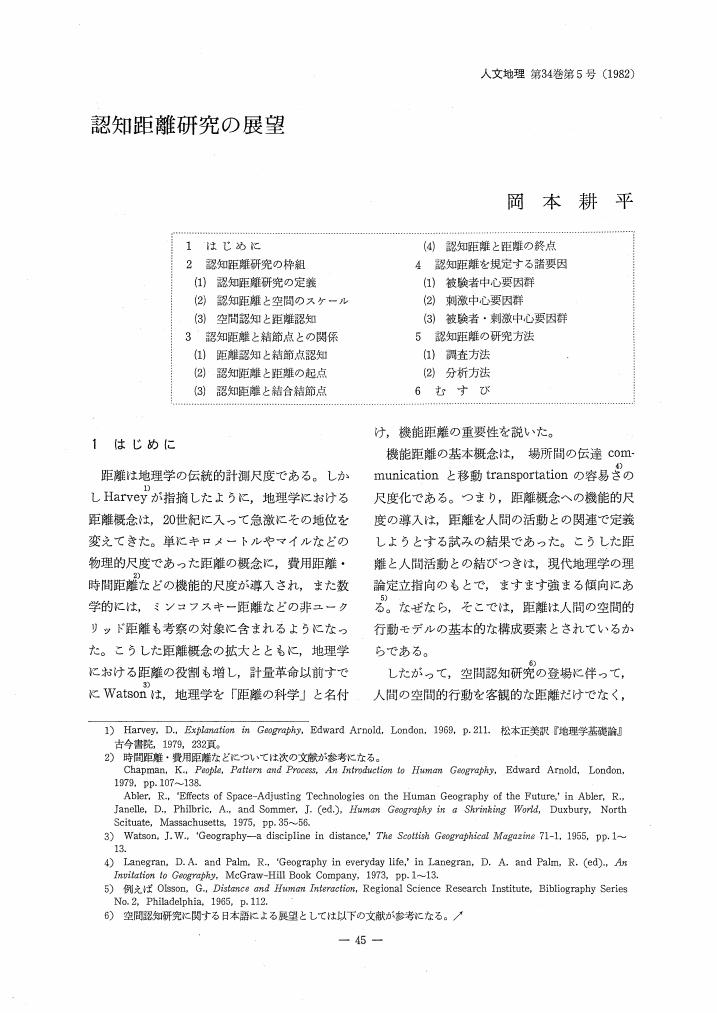3 0 0 0 OA 地名標準化の現状と課題―地名委員会(仮称)の設置に向けて―
- 著者
- 高木 彰彦 岡本 耕平
- 出版者
- 公益社団法人 日本地理学会
- 雑誌
- E-journal GEO (ISSN:18808107)
- 巻号頁・発行日
- vol.12, no.1, pp.143-146, 2017 (Released:2017-09-30)
2 0 0 0 OA 手描き地図を用いた空間認知研究へのGISの適用
- 著者
- 高井 寿文 奥貫 圭一 岡本 耕平
- 出版者
- Japan Cartographers Association
- 雑誌
- 地図 (ISSN:00094897)
- 巻号頁・発行日
- vol.41, no.4, pp.27-36, 2003-12-28 (Released:2011-07-19)
- 参考文献数
- 13
2 0 0 0 OA 認知距離研究の展望
- 著者
- 岡本 耕平
- 出版者
- The Human Geographical Society of Japan
- 雑誌
- 人文地理 (ISSN:00187216)
- 巻号頁・発行日
- vol.34, no.5, pp.429-448, 1982-10-28 (Released:2009-04-28)
- 参考文献数
- 89
- 被引用文献数
- 7 1
2 0 0 0 OA 海外フィールドワークによる地理的知と大学地理学教育への還元
- 著者
- 池口 明子 岡本 耕平
- 出版者
- 公益社団法人 日本地理学会
- 雑誌
- E-journal GEO (ISSN:18808107)
- 巻号頁・発行日
- vol.8, no.1, pp.48-58, 2013 (Released:2013-04-19)
- 参考文献数
- 21
- 被引用文献数
- 1
本稿は,海外フィールドワークによる地理的知の還元の1つのモデルとして,大学地理学教育への還元を提案し,その課題をラオスにおける実践例に基づき検討した.市場経済化にともなう土地利用計画の変化や観光化を受けて,ラオス国立大学ではGIS(地理情報システム)や地誌教育のニーズが高まっている.GIS教育への還元において筆者らは,単にコンピューターの操作や地図情報の提供ではなく,地図を作成するプロセスを重視し,ラオス農村で自ら用いたGPSによるデータ作成法を教員らと実践した.地誌教育においてはフィールドワークの成果に合わせて日本の農山漁村の問題も提示するなどの工夫により,調査する側とされる側の双方の研究教育機関による地理的知の創造を目指す必要がある.
2 0 0 0 OA 東南アジア平原地帯における複合的な資源利用とその持続的発展に関する研究
- 著者
- 野間 晴雄 野中 健一 宮川 修一 岡本 耕平 堀越 昌子 舟橋 和夫 池口 明子 加藤 久美子 加納 寛 星川 和俊 西村 雄一郎 鰺坂 哲朗 竹中 千里 小野 映介 SIVILAY Sendeaune 榊原 加恵 SOULIDETH DR.MR. Khamamany BOURIDAM MS. Somkhith ONSY Salika CHAIJAROEN Sumalee 岡田 良平 的場 貴之 柴田 恵介 瀬古 万木 足達 慶尚 YANATAN Isara 板橋 紀人 渡辺 一生
- 出版者
- 関西大学
- 雑誌
- 基盤研究(A)
- 巻号頁・発行日
- 2006
東南アジア大陸部に位置する天水田農業を主体とした不安定な自然環境における平原地帯(東北タイドンデーン村とラオスのヴィエンチャン平野ドンクワーイ村)における多品種の稲や植物,魚介類や昆虫など様々な動植物資源の栽培・採集・販売などの複合的な資源利用の実態とその変化の態様を地域の学際的・総合的共同調査で明らかにした。両村ともグローバル市場経済の影響が認められるが,ドンデーン村ではかつて存在した複合的な資源利用が平地林の消滅や都市近郊村落化によって失われており,ドンクワーイ村はグローバル化や森林伐採で変容を遂げつつあるが,インフラの未整備によって伝統は保持されている。
1 0 0 0 OA 名古屋市における認知距離
- 著者
- 岡本 耕平
- 出版者
- The Association of Japanese Geographers
- 雑誌
- 地理学評論 (ISSN:00167444)
- 巻号頁・発行日
- vol.56, no.10, pp.695-712, 1983-10-01 (Released:2008-12-24)
- 参考文献数
- 18
- 被引用文献数
- 8 2
本稿の目的は,名古屋市における認知距離をできるだけ多様な角度から検討することによって,研究方法の違いを越えて認められる認知距離の基本的性質を明らかにすることである.分析の結果,認知距離を規定する要因は,被験者の属性より,むしろ起点(被験者の位置),終点,認知される距離の種類などの刺激中心要因群であることがわかった.刺激中心要因群は,都市構造と関係するr本研究では特に,起点を複数選定し,しかも直線距離と時間距離の認知形態を比較した結果,名古屋市の都市構造が認知距離に及ぼす影響を見い出した.また名古屋市では,都心方向への距離は,都市縁辺方向への距離に比べて過小評価され, Lee (1970) の結果を支持した.
1 0 0 0 OA 行動地理学の歴史と未来
- 著者
- 岡本 耕平
- 出版者
- The Human Geographical Society of Japan
- 雑誌
- 人文地理 (ISSN:00187216)
- 巻号頁・発行日
- vol.50, no.1, pp.23-42, 1998-02-28 (Released:2009-04-28)
- 参考文献数
- 183
- 被引用文献数
- 5 4
Behavioral geography, which started in the 1960s, had lost its impetus on account of internal division and various criticism from radicals and humanists in geography after about 1980. Because of its perceived lack of social relevance at a time when social issues had become the major focus of human geography, behavioral research was often relegated to a minor role within the discipline.Behavioral geography, however, has revitalized since 1990. This stems from two sources: the theoretical pluralism in post-modern geography and interdisciplinary studies with psychology, cognitive science, and GIS.This paper has three purposes. First, it outlines a history of behavioral geography and describes its revitalization in the 1990s. Second, the geographical studies on cognitive map and cognitive mapping, which has been the most important research theme in behavioral geography, are critically examined. Third, this paper pursues the future development of behavioral geography surveying the new ideas in recent psychology and examining the raison d'être of cognitive studies in human geography.In discussion, this paper makes the following pleas. 1) Behavioral studies in geography should look hard at routinized non-awareness activities in our daily lives in societal and cultural context. 2) The focus of the study should be on ‘behavior in space’, not on‘spatial behavior’, 3) The study on ‘vista’ will bring fertile perspectives to behavioral geography. 4) Behavioral geographers should notice that human spatial knowledge has various aspects.
1 0 0 0 OA 特集「フィールドワークと地理的知の還元」によせて
- 著者
- 岡本 耕平
- 出版者
- 公益社団法人 日本地理学会
- 雑誌
- E-journal GEO (ISSN:18808107)
- 巻号頁・発行日
- vol.8, no.1, pp.1-2, 2013 (Released:2013-04-19)
- 参考文献数
- 4
1 0 0 0 行動地理学の歴史と未来
Behavioral geography, which started in the 1960s, had lost its impetus on account of internal division and various criticism from radicals and humanists in geography after about 1980. Because of its perceived lack of social relevance at a time when social issues had become the major focus of human geography, behavioral research was often relegated to a minor role within the discipline.Behavioral geography, however, has revitalized since 1990. This stems from two sources: the theoretical pluralism in post-modern geography and interdisciplinary studies with psychology, cognitive science, and GIS.This paper has three purposes. First, it outlines a history of behavioral geography and describes its revitalization in the 1990s. Second, the geographical studies on cognitive map and cognitive mapping, which has been the most important research theme in behavioral geography, are critically examined. Third, this paper pursues the future development of behavioral geography surveying the new ideas in recent psychology and examining the raison d'être of cognitive studies in human geography.In discussion, this paper makes the following pleas. 1) Behavioral studies in geography should look hard at routinized non-awareness activities in our daily lives in societal and cultural context. 2) The focus of the study should be on 'behavior in space', not on'spatial behavior', 3) The study on 'vista' will bring fertile perspectives to behavioral geography. 4) Behavioral geographers should notice that human spatial knowledge has various aspects.
1 0 0 0 OA インド洋大津波の被災・緊急対応・復興過程と社会的メカニズム
- 著者
- 高橋 誠 田中 重好 木村 玲欧 島田 弦 海津 正倫 木股 文昭 岡本 耕平 黒田 達朗 上村 泰裕 川崎 浩司 伊賀 聖屋
- 出版者
- 名古屋大学
- 雑誌
- 基盤研究(A)
- 巻号頁・発行日
- 2008
インド洋大津波の最大被災地、インドネシアのバンダアチェとその周辺地域を事例に、被災から緊急対応、復興過程についてフィールド調査を行い、被害の状況、被害拡大の社会・文化的要因、避難行動と緊急対応、被災者の移動と非被災地との関係、住宅復興と地域の社会変動、支援構造と調整メカニズム、災害文化と地域防災力などの諸点において、超巨大災害と地元社会に及ぼす影響と、その対応メカニズムに関する重要な知見を得た。



